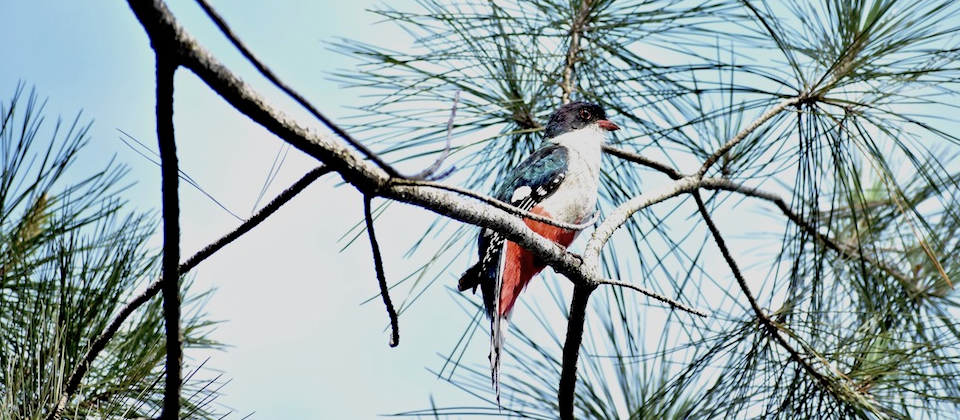
Published on 31 May, 2019.
Cuba is a birdwatching paradise in the insular Caribbean. The Baracoa region offers birding and twitching adepts a wide range of bird species to discover in various protected areas and types of habitats.
Indeed, a large number of resident birds, including beautiful endemic species and sub-species can be observed in our region – not to mention significant numbers of migrant species. Here’s an endemic bird of Cuba and the Bahamas: the Cuban Emerald hummingbird (Riccordia ricordii, formerly known as Chlorostilbon ricordii). In Spanish we call it zunzún.
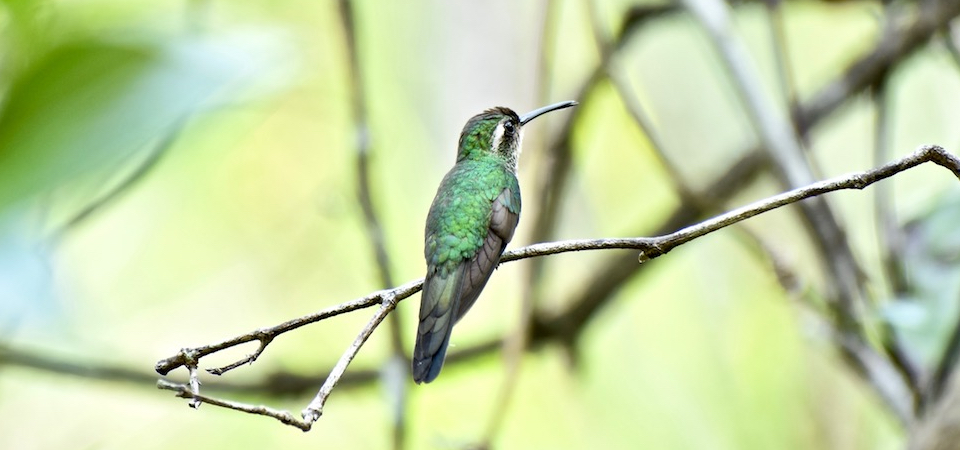
In this post, we take you to the Loma de Piedra trail in Alexander Humboldt National Park, in Baracoa. It comprehends some of the best birdwatching zones in the accessible areas of the park – but also a large sample of endemic flora and great lookout points! Except where indicated, all pictures posted here were taken there last April 28th, 2019.
Useful things to know about birding in Cuba
Cuban bird experts Orlando H. Garrido and Arturo Kirkconnell point that in the winter you will be able to observe a larger number of species, as migrant birds can be spotted too in the island. You can thus see what they look like when they are away from their usual environment.
Take for instance this female Black-Throated Blue Warbler (Setophaga caerulescens) wintering here but originally from North-Eastern North America. Its name in Spanish is bijirita azul de garganta negra.
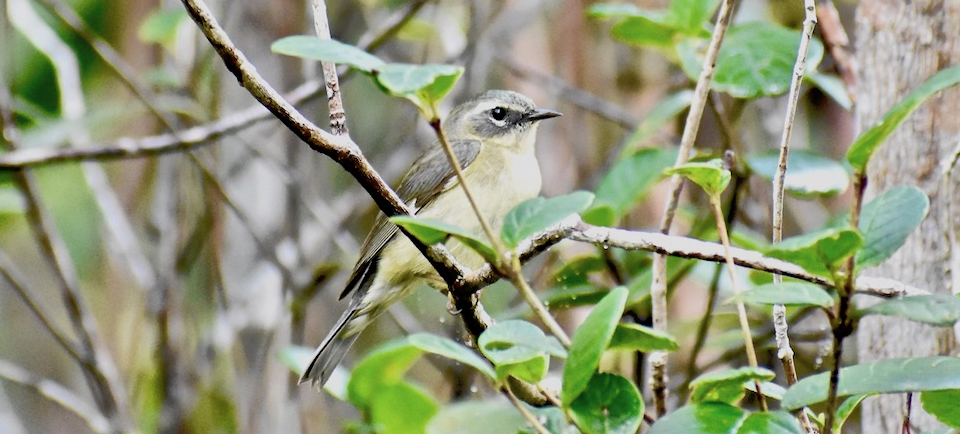
On the other hand, Garrido and Kirkconnell highlight that summertime allows the birding adept to focus on native species as they show greater activity levels. Summer is the time of reproduction – courtship, increased vocalization, nest-building, breeding…
Birding in the Baracoa region
The winter months (November through March) offer cooler temperatures for hiking and birdwatching. That said, the days are shorter in November and December and they only start becoming a bit longer January to February. This picture of Cuban endemic pine Pinus cubensis was taken at 7:35 a.m.
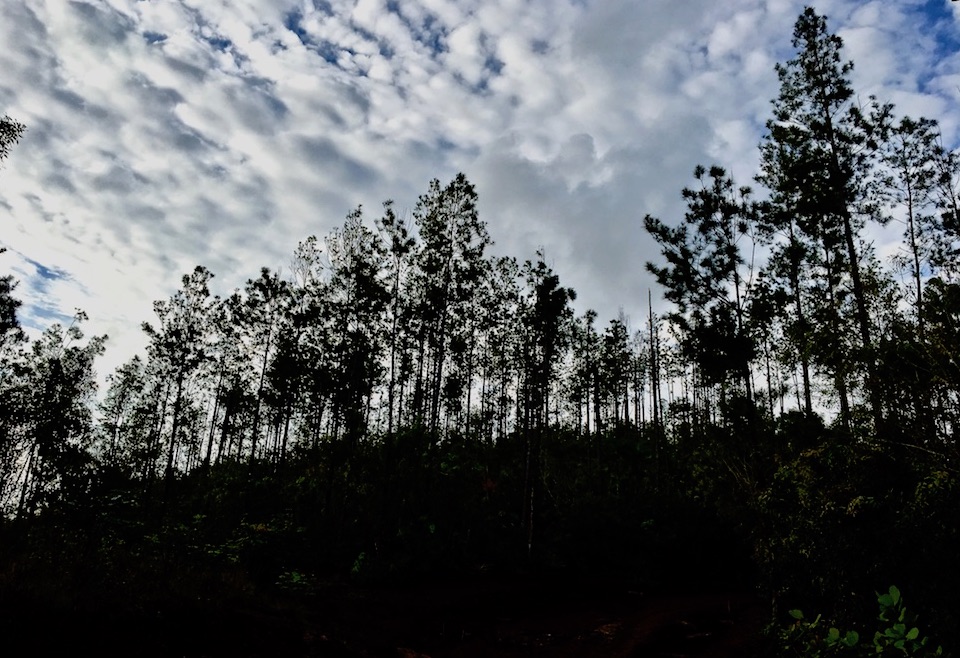
Baracoa is known for its significantly high yearly rainfall levels. That said, the rainiest months include May and part of June then a part of September, all of October and part of November. Mosquitoes thrive during rainy periods – you better wear long sleeved shirts and long pants, and don’t forget a good repellent!
Alexander Humboldt National Park offers some of the best birding areas in Baracoa. But you also have nice birdwatching opportunities in other protected areas such as flat top mount El Yunque, Yara-Majayara and in Maisi, you have Pozo Azul and Punta del Fraile.
Loma de Piedra trail in Humboldt Park
Loma de Piedra is the longest trail currently doable on a single day at Humboldt Park, roughly 8 km long. In this post we will offer you a few pictures of the trail’s endemic flora – and of some of its best lookout points. This will give you a better idea of other natural and landscape aspects of Loma de Piedra’s birding environment. The next picture was taken on December 4th, 2018.
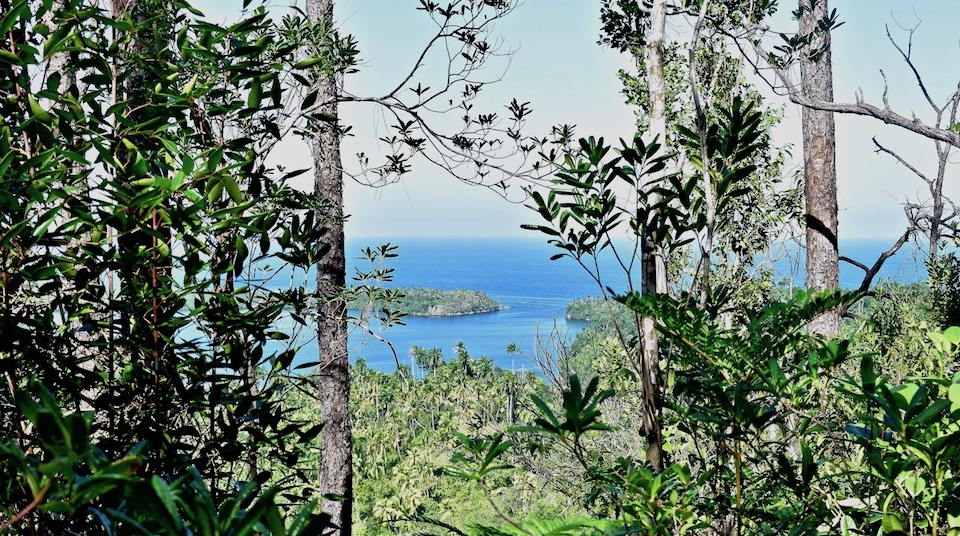
For our Loma de Piedra hike, we were fortunate to count on one of Humboldt Park’s best guides for birding. Extremely well-informed, attentive to detail and sensitive, the guide very effectively helped us spot a large number of species and shared with us his approaches to respectful birding. He knows the park like the palm of his hand…
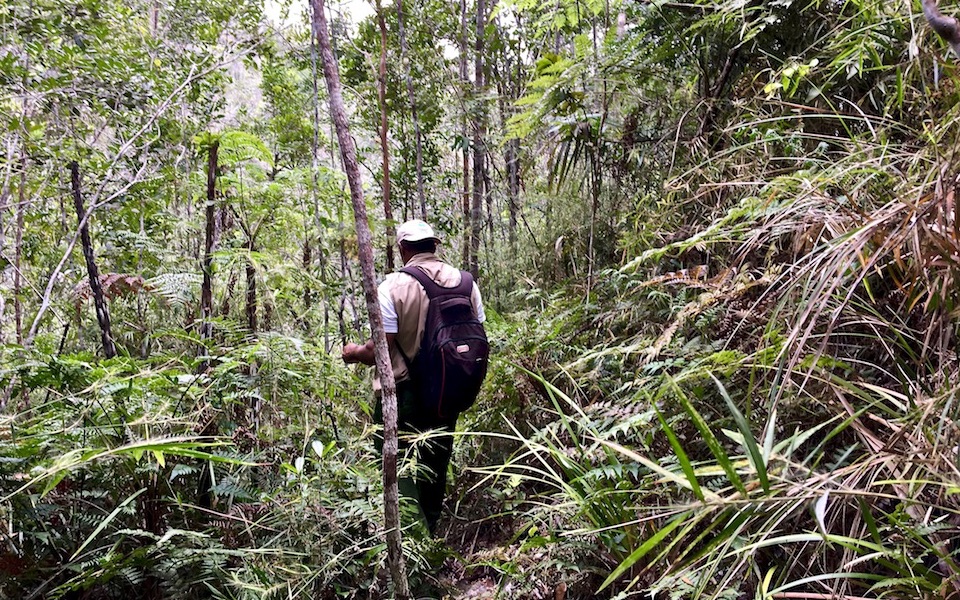
Since we’re only beginners and have modest equipment for bird photography, we share here only the 10 best bird pictures we took during our hike. Here’s one of our favourite endemic Cuban birds: the Cuban Pygmy-owl (Glaucidium siju). Or you can call it sijú planatero, in Spanish. At 6.5 inches, it’s a small owl that lives on all types of forest environments. It stood there for quite a while, patiently looking at us as we tried and tried again to photograph it…
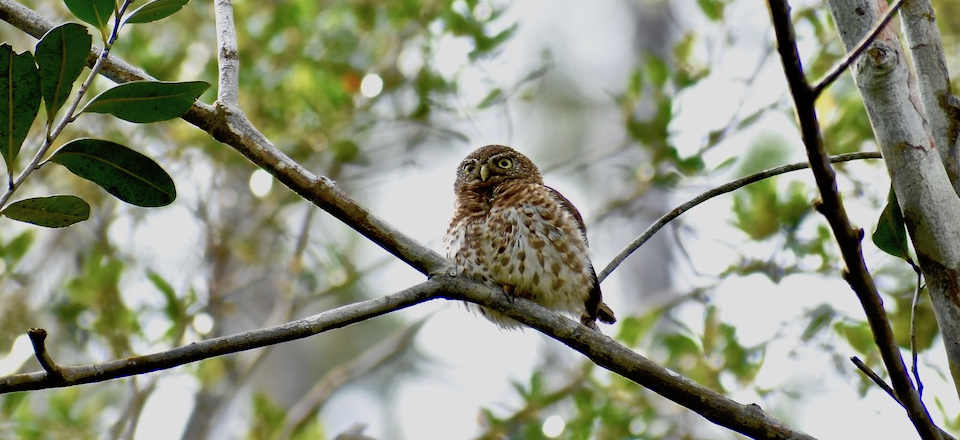
Birdwatching in the midst of beautiful protected flora
As mentioned above, the Loma the Piedra trail showcases a significant sample of Alexander Humboldt National Park’s flora. This is a very delicate orchid called Bletia purpurea. Late April is a great time of the year to see lots of them blossoming here.
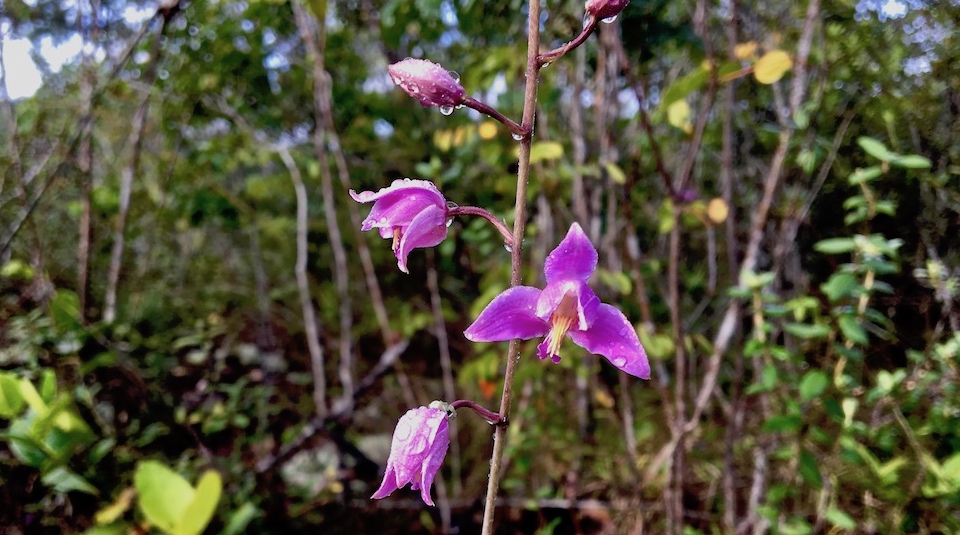
Here you see a very ancient plant species is a Dracaena cubensis, one of the Cuban endemic plants you’ll come across in the Baracoa region.
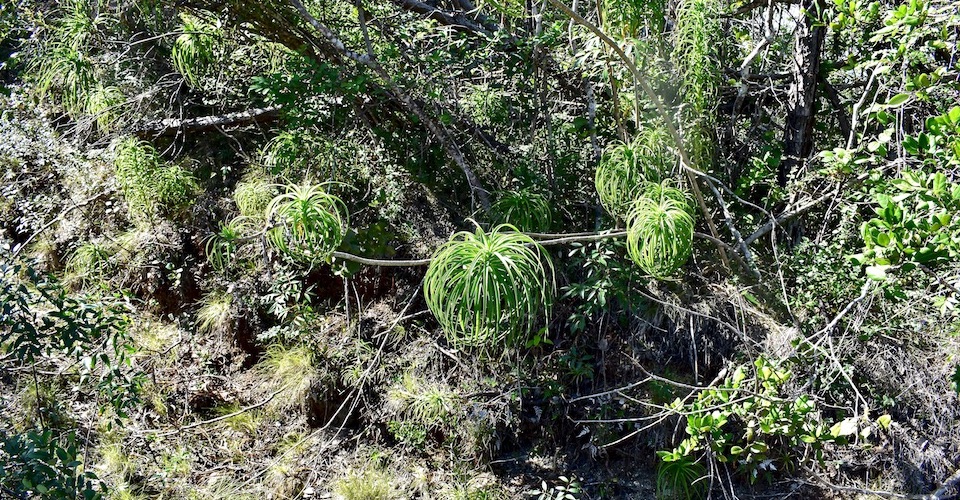
Now, let’s get back to our birds. This lovely acrobat here is endemic of Eastern Cuba – the Oriente Warbler (Teretistri fornsi). Its name in Spanish? Pechero. It measures 5.25 inches, lives in forests and thickets from sea level to high mountains and has highly variable foraging habits.
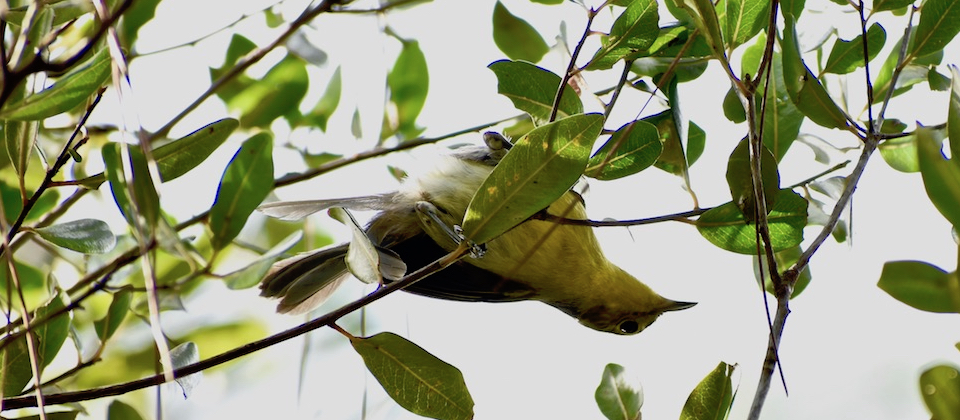
Now check out this Western Spindalis (Spindalis zena pretrei, formerly called Stripe-headed Tanager), a subspecies endemic to Cuba. If you are talking to a Cuban in Spanish, you should call this bird cabrero. The male is a riot of bright colours. Adults measure 6 inches, they build their nests on high branches and eat fruit, seeds and small insects.
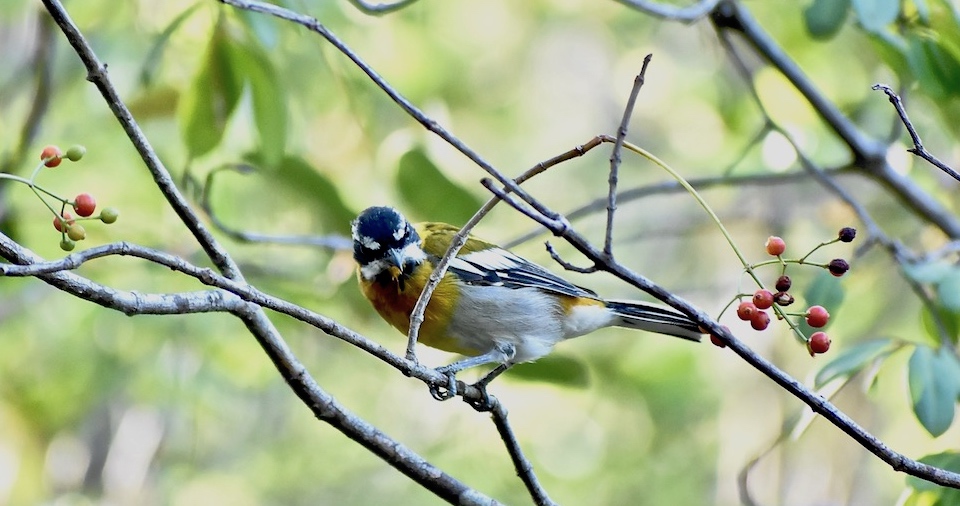
Shifting landscapes at Loma de Piedra trail
The type of soil changes as you pursue your hike – and so does the vegetation. Colourful flowers dot the trail. This red beauty is a Euphorbia helenae, called by Cubans jazmín del pinar (literally: pine tree forest jasmine).
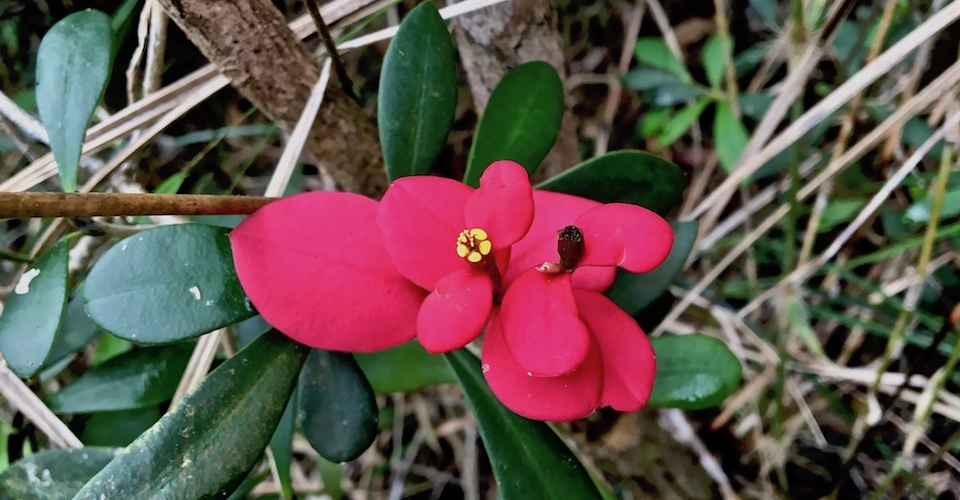
And these thorny-trunked palm trees are endemic too – Bactris cubensis. Locals call it pajúa or pajuá – you’ll always see them in tight clusters.
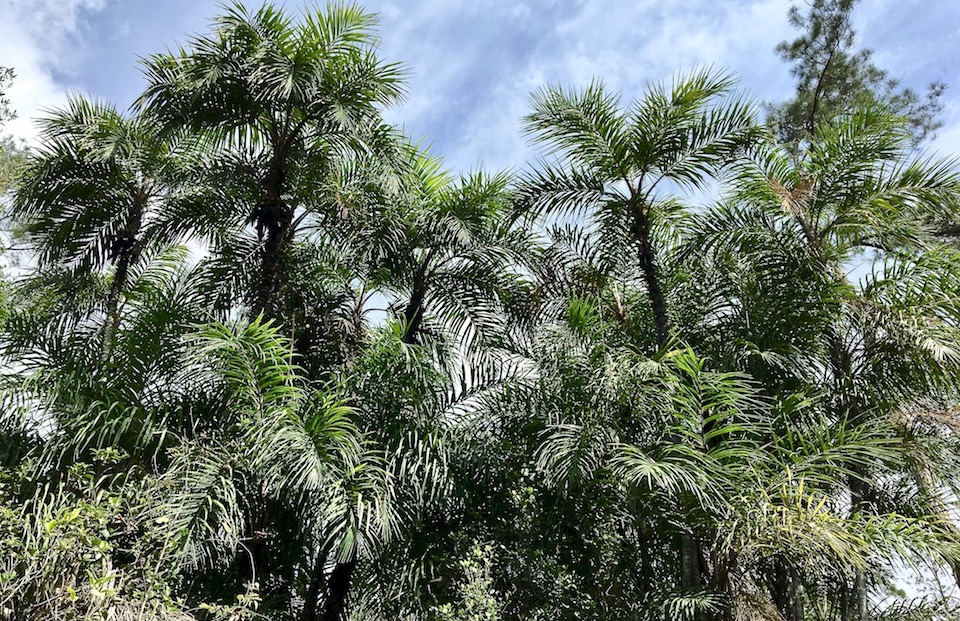
This tiny riot of colours is a Cuban Tody (Todus multicolor, 4.25 inches) and it can be seen on different stretches of the Loma de Piedra trail. It moves very quickly and does not stay put if it feels your presence nearby. Its wings produce a special whirring sound when it flies. It’s another one of our very favourite Cuban endemic birds – in Cuba, we call it cartacuba.
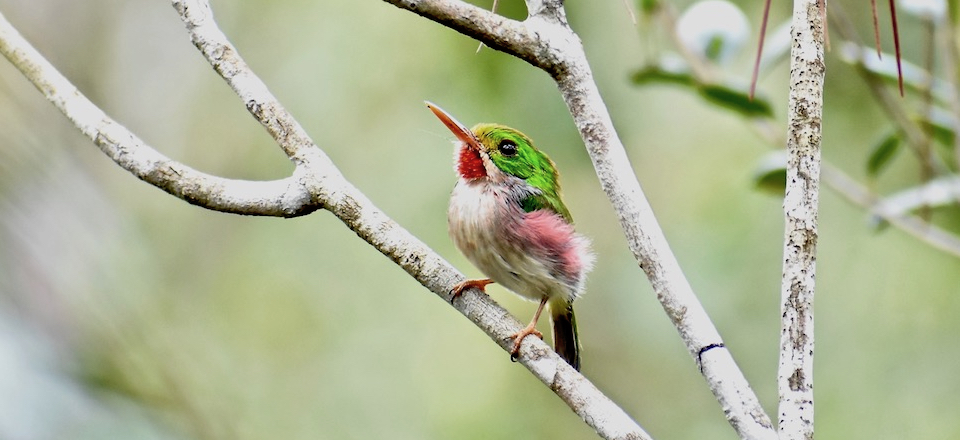
And this one here is a Yellow-Faced Grassquit (Tiaris olivaceus, 4.5 inches). It lives from southern Mexico to northern Ecuador and Venezuela, and across the Caribbean. We like its smooth olive back and bright yellow, almost orange supercilia and throat. Its Spanish name is tomeguín de la tierra. Its nest is spherical with a side entrance, built out of dry grasses, little roots and plant fibers.
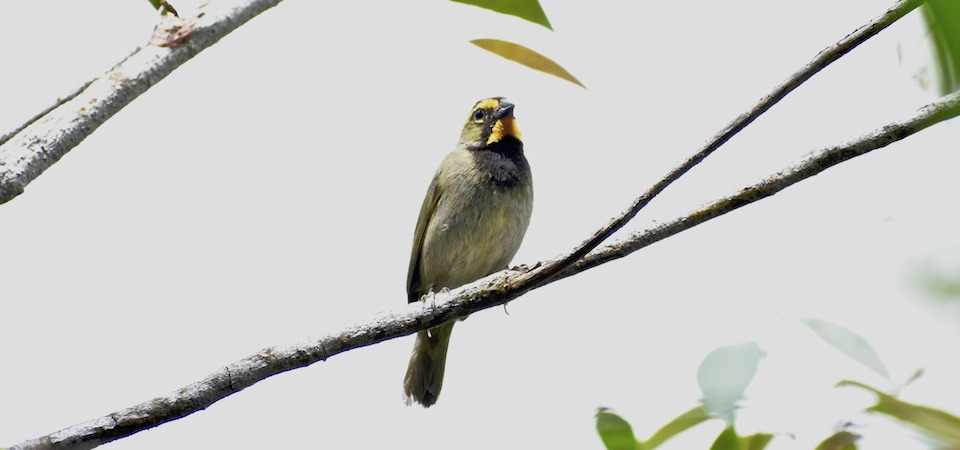
Loma de Piedra trail – amazing lookout points
There are several lookout points along the Loma de Piedra trail – some of them quite special. This one here is at a height of 700 ft above sea level. You can see Taco Bay, in the maritime portion of Alexander Humboldt National Park and the coastline stretching towards the north. A great spot to make a stop and take in the landscape…
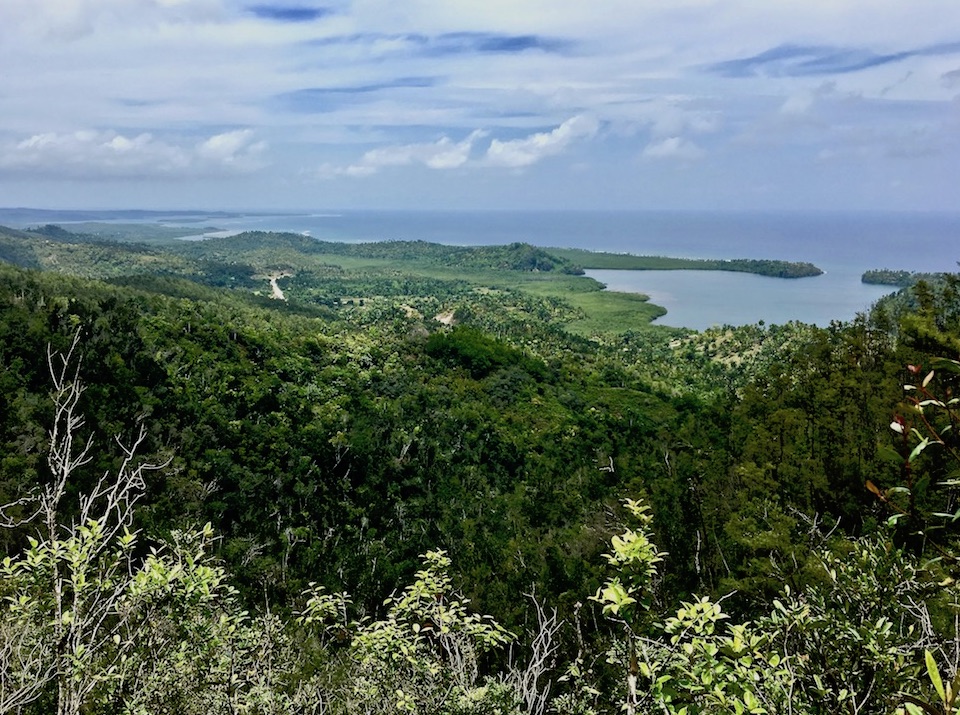
Here’s another lovely orchid, endemic of the Nipe-Sagua-Baracoa mountain range, hanging high on a palm tree trunk at the Loma de Piedra Trail. It’s an Encyclia hamiltonii. This picture was taken last December 4th, 2018.
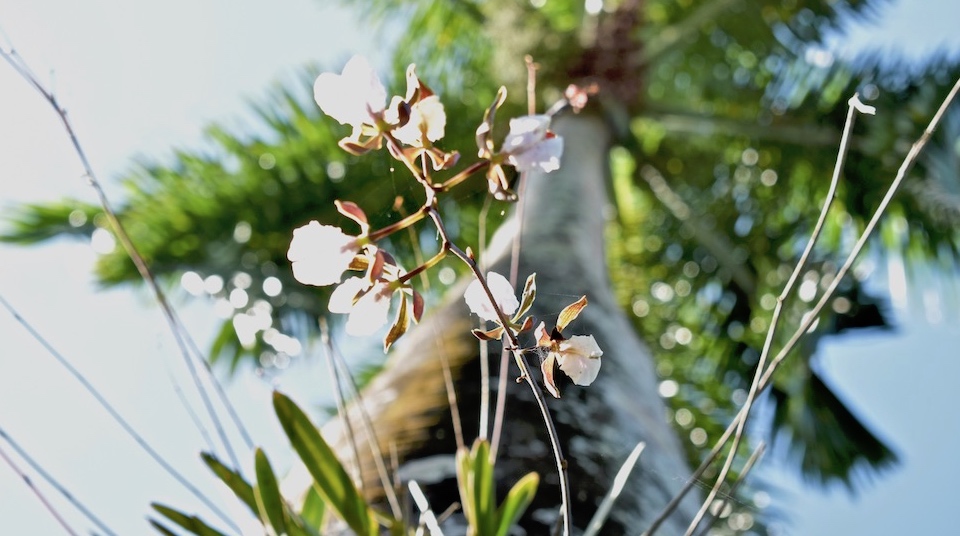
We were lucky to have this Red-legged Thrush (Turdus plumbeus schistaceus, 10.5 inches) pose for us for a few minutes. It is native to several Caribbean islands and the species sports a couple of colour variations on its belly. Its feathers are slate gray with a slight blue hue and, in the case of this Eastern Cuban subspecies, the lower belly does not have a rufous colour. It feeds on small insects, lizards and fruits. In Cuba we call it zorzal.
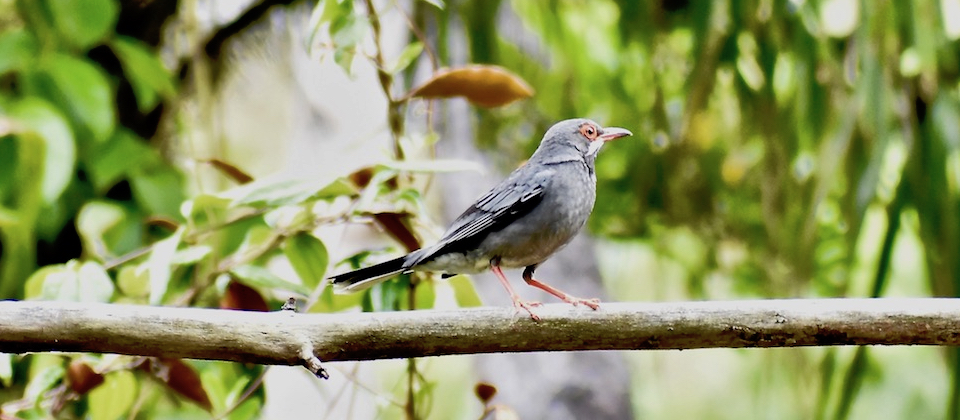
As we continue to hike, in the more humid areas we find several types of fungi, some of them very colourful – not unlike the zorzal’s eyes and legs.
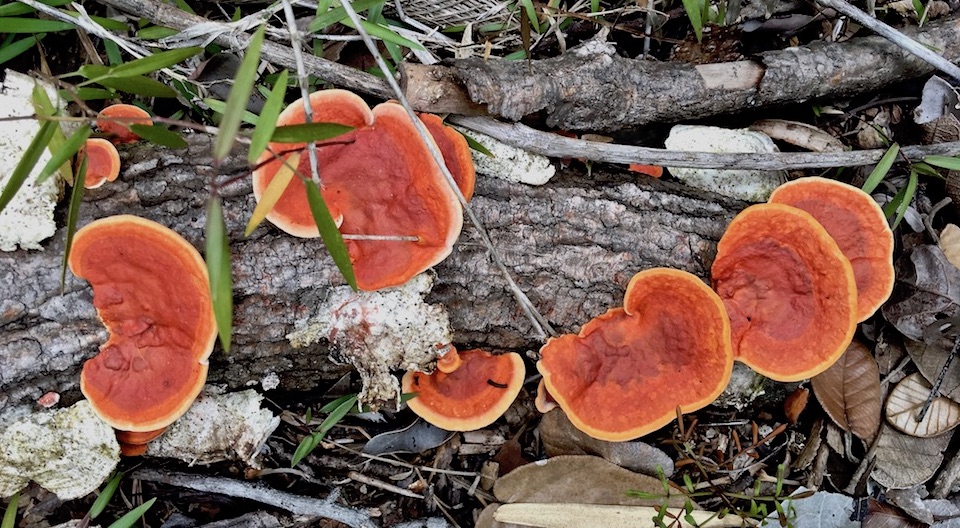
And on rocky terrain, we found another delicate, Cuban-endemic orchid – the Tetramicra tenera.
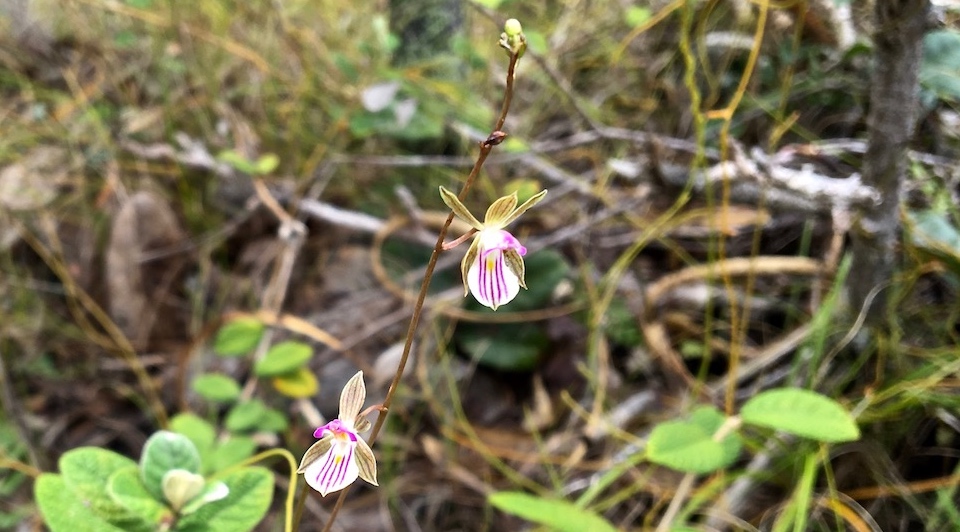
Before we conclude – two more amazing Cuban endemic birds!
A Cuban Green Woodpecker (Xiphidiopicus percussus, 9 inches) moved briskly by its nest, high on a pine tree. We call it carpintero verde and it loves a range of other trees as well, including palm trees and fruit trees. Its wings produce a peculiar sound when flying and it feeds on bark crack-hidden insects, small fruits and frogs.
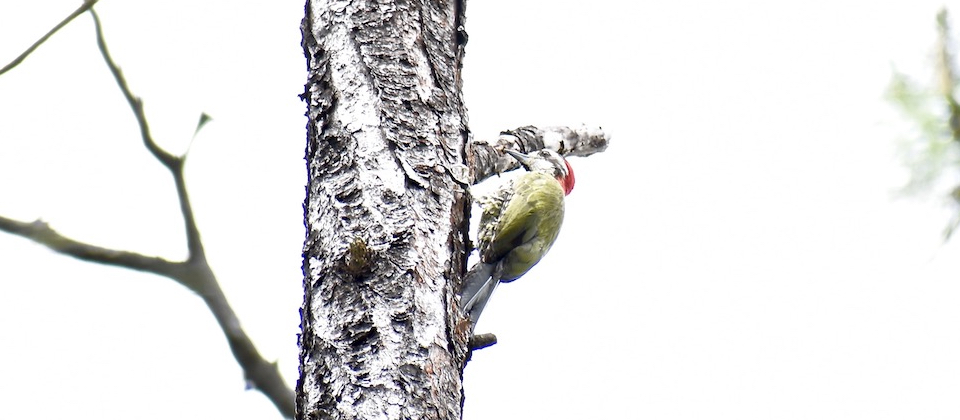
And last but certainly not least, behold Cuba’s national bird: the Cuban Trogon (Priotelus temnurus)! You will hear its Spanish name often in our country – tocororo (some folks call it tocoloro). It measures 10.5 inches and it can be spotted several times at different places along the Loma de Piedra trail. It is a rather calm bird – it doesn’t fly away quickly and allows you to get relatively close and move around it. This one stood there between the branches, like in a dream…
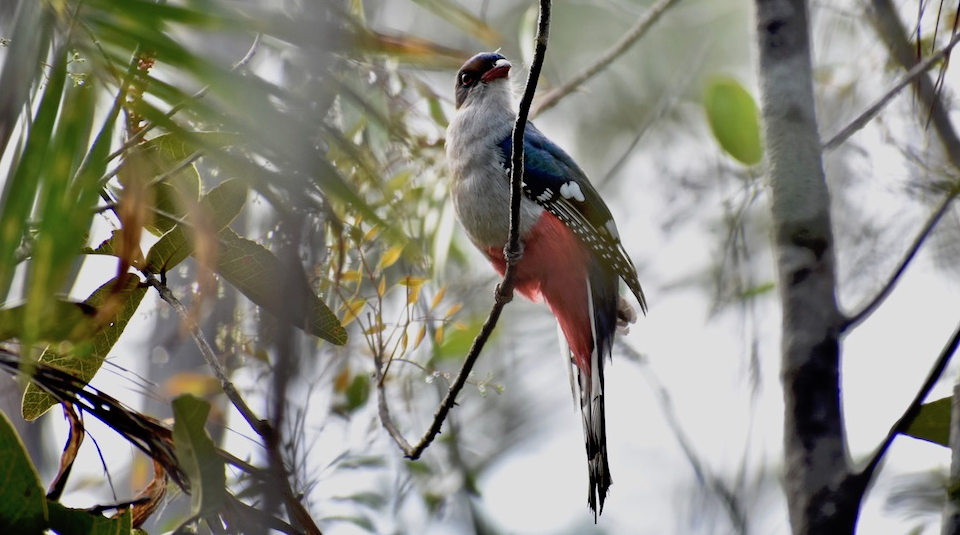
During our hike last April we also spotted but were unable to produce minimally nice photos of the Cuban-endemic Bee Hummingbird (Mellisuga helenae), the Cuban Pewee (Contopus caribaeus) and the Great Lizard-Cuckoo (Coccyzus merlini). We promise to add those and other species as soon as we go back to Humboldt Park and photograph them for you!
You can also check our post on birding in other protected areas… In the meantime, here’s a Green Heron (Butorides virescens, 18 inches). Called aguaitacaimán in most of Cuba, here in Baracoa we call it matuango. We caught this one on May 17th, 2019 near El Manglito beach.
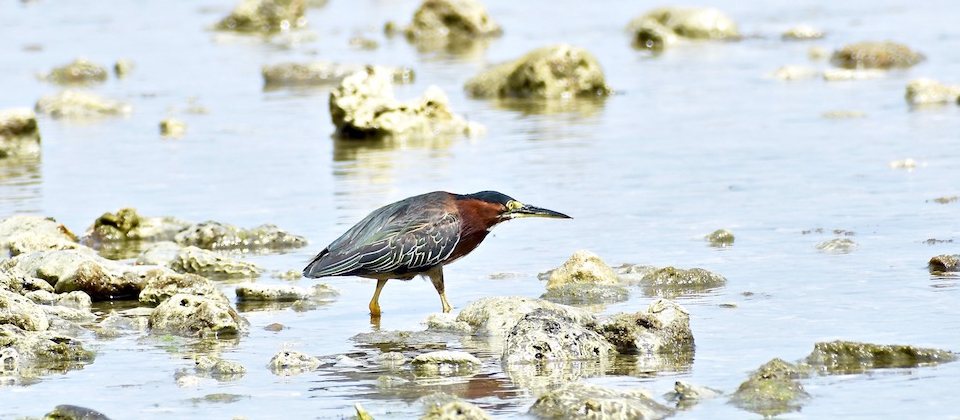
Did you know?
There are 21 bird species and 38 subspecies found only in Cuba.
One endemic species, the Cuban Macaw (Ara tricolor) has long been extinct – the last specimen was taken from the Zapata peninsula as far back as 1864.
Another important endemic species that is labelled critically endangered and considered by many as being probably extinct is the Cuban Ivory-billed Woodpecker (Campephilus principalis bairdii, 19 inches). Any remaining individuals are thought to live in the Cuchillas del Toa mountains and the Sierra Maestra. Several expeditions since the 1990s have failed to spot it, including one in 2016 by expert birders Tim Gallagher and Martjan Lammertink.
As is the case in many places around the world, various bird species in Cuba are victims of unscrupulous traffickers. Needless to say, the birds at Alexander Humboldt National Park are adequately protected.
Practical information and budget details
- We’re happy to help our guests organize their birding excursions in the Baracoa region and nearby important birding areas, including matching them with the best guides in each area.
- The various trails in Humboldt Park count on excellent guides who belong to local communities and who know these lands since their childhood. Their knowledge covers the history of the protected area, the flora and the fauna, the area’s peasant culture and traditional medicine. Using a guide is compulsory – you cannot explore the park unaccompanied.
- To access the National Park, you have to go through the facilities at the entrance, which have a Visitors Centre as well as washrooms.
- The price for hiking the Loma de Piedra trail is 1,845 CUP per person and that includes the guide service.
- Ecotur agency runs excursions from Baracoa for a global price of 56 EUR (or USD) per person (for the Loma de Piedra trail), which includes transportation (round), the entrance fee, the guide service and, on the way back, a one-hour stop at Maguana beach.
- If you’d rather get to the park on your own, a taxi for the day to Humboldt Park charges 50 EUR (or USD). If you share this expense with 3 other travellers, the cost per person decreases significantly.
- Don’t forget to bring with you water to drink and a sandwich or other form of food.
- We encourage you to offer your guide a tip, an always welcome extra bit of income for a local family. Likewise, we encourage you to buy from local women at the park entrance the sweets they offer to visitors (almond or peanut brittle, or the grated coconut cucuruchos typical of Baracoa). Such treats can be a good source of energy during the hike. And such little expenses help more local families benefit from a sustainable tourism.
- We invite you to learn more about sustainable tourism in the Baracoa region.
- Don’t miss the photos and videos of El Copal trail and El Recreo trail in Alexander Humboldt National Park, as well as the photos and videos of Taco Bay and the Balcon de Iberia trail.
- The book Field Guide to theBirds of Cuba, by Cuban bird experts Orlando H. Garrido and Arturo Kirkconnell (Cornell University, 2000), allows you to learn more about birds in our country. That said, ornithology science makes progress and so does bird taxonomy and species names. A more recent publication is Nils Navarro’s Endemic Birds of Cuba (2015) – and the most up-to-date source you can access is Navarro’s Annotated Checklist of the Birds of Cuba, with a new version every year.
Activities, Baracoa, Sustainable Tourism
Tags: Adventure Tourism, Birdwatching, Ecology, Forests, Hiking, Nature Tourism, Trails

Recent Comments
You are waaaaay too modest! These bird photos are stunning, not to mention the flowers and that delicious view. How wonderful to have so many beautiful species of birds and so glad to hear they are protected. Cuba’s national bird is gorgeous. Birding–another great reason to visit your paradise in Baracoa!
Thank you, Cynthia! We are really learning and our photograph equipment is quite modest, but yes – some of the pictures turned out really well and we are very happy with them! In other pics, the birds were too far or the light behind them too much and thus the pic ended up overexposed. We’ll keep trying, for sure! 😉
Although we had seen birds in our region a number of times in the past, we’re also new to birding and we’re nowadays discovering more and more species in different habitats, many of them protected, indeed. We’ll keep posting about them!
So many beautiful plants and animals.. my favourite bird has to be the Tody, would love to hear the special whirring sound when the little feller takes off.
Thanks, Stefan! Yes, the Loma de Piedra trail keeps surprising you with amazing flora and fauna at every turn. We never tire of it! And the Cuban Tody is plain irresistible – he never fails to charm and captivate folks who meet him (for the first or the 100th time)! 🙂